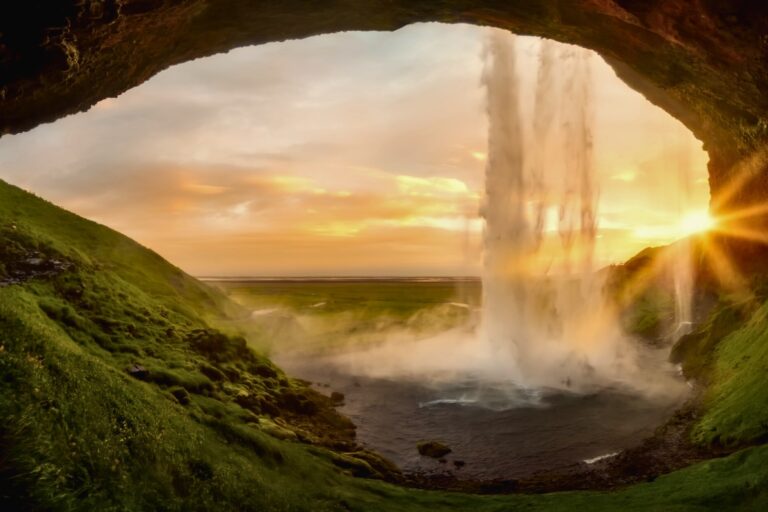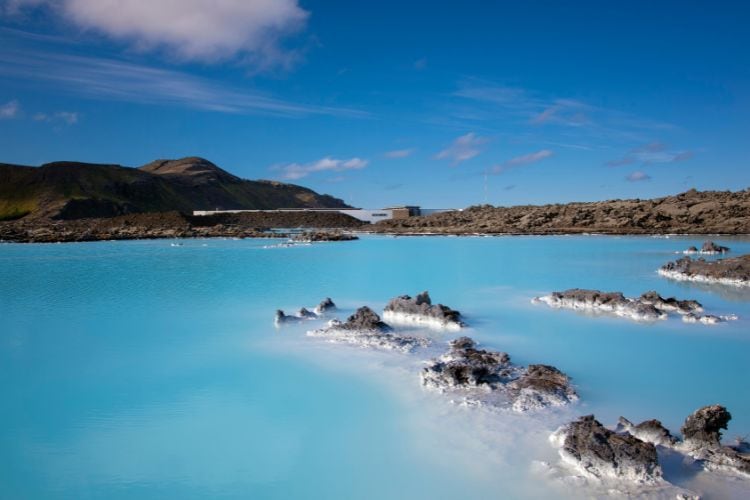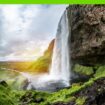
Our eagerness is palpable as my partner and I undertake an expedition to Iceland in August, usually a warm month with average daily temperatures of 50-59°F.
We have fished our way down many rivers on hot summer days and perspired our way through the Amazon, so we are looking forward to arctic breezes and cool, clear streams.
A chilly blast of wind welcomes us as we deplane and set off for the Golden Circle route in southern Iceland. One can drive the route that covers about 140 miles in just over 3 hours, but who would want to do that when there is so much to see?
Looping from Reykjavík and back, its main features are Þingvellir National Park, Gullfoss Waterfall, and the geothermal area in Haukadalur.
Geysir and Strokkur geysers are in Haukadalur. Geysir has been mostly dormant for many years, but Strokkur erupts every 5–10 minutes.
Other stops include Hellisheiðarvirkjun geothermal power plant. We plan to see it all.
Thingvellir and the Viking Connection

In Þingvellir Park (Thingvellir), we brave the wind to walk right through the mountainous divide of the North Atlantic Ridge.
Iceland sits atop the European and North American tectonic plates, where magma welling up from the earth’s core constantly creates new land as the plates drift apart. It’s exciting to climb to the top and stand atop the split that is moving imperceptibly, but constantly.
This cleft in the mountains of Thingvellir is where the Vikings held congressional gatherings from 930 AD until 1798. They named the surrounding area the Valley of the Gathering (or Þingvellir).
At least forty clans converged annually to recite laws, make speeches, present ideas and submit proposals. It was also a two-week festival with merchants, storytellers and traders bustling about the site.
It’s a UNESCO World Heritage site because the oldest parliament in the world gathered here. Fragments of around 50 booths built from turf and stone are visible remnants of the gatherings.
Geysir and Gullfoss

The frigid wind accompanies us as we approach the Geysir Geothermal area, where the explosive power of Strokkur geyser streaks skyward. Iceland, with its geothermal activity and black lava fields twisted with rope-like coils, resembles Yellowstone Park, though Iceland is vaster.
Our noses detect pungent sulfur wafting from the mustard-yellow rivulets spewing from percolating mud, just like it does on the Yellowstone lunar landscape. We’re surrounded by sky-blue hot pools and steaming fields, so the sulfur odor is a minor inconvenience.
We observe short, stocky Icelandic horses as we drive to Gullfoss Waterfall. The Icelanders developed the breed for its sure-footedness and ability to cross rough terrain.
The Circle extends farther to reach Gullfoss Waterfall, where we traverse a narrow path and get a close-up view of the massive, two-tiered waterfall below.
Hengill Geothermal Area

Hengill is a high-temperature geothermal area about 20 miles east of Reykjavík. It’s there we see the Hellisheiðarvirkjun geothermal power plant, the largest power plant in Iceland. Geothermal activity is Iceland’s savior.
Although there are dams in the highlands that produce energy as well, Hellisheiðarvirkjun not only heats homes but also enables greenhouses to generate substantial amounts of produce, even when there are fewer than four hours of daylight in the winter.
The Famous Blue Lagoon

As we wrap up the Golden Circle, we stop at the Blue Lagoon, about a 40-minute drive west of Reykjavik. What a delight it is to submit to the allure of the Blue Lagoon.
The superheated water, a byproduct from the nearby geothermal power plant, creates a hot-water playground that wraps its warmth around us.
The cerulean blue sky reflects the white silica in the water, and the resulting milky blue water is luminous and irresistible. We enjoy a cool drink from the in-pool bar to make it even more irresistible. Though it is presently open, this area is at risk because of recent volcanic activity.
Our meals have been delicious choices of Icelandic food. We feasted on succulent lamb soups and stews. We’ve savored thick, juicy reindeer hamburgers and spicy reindeer sausage. The sushi using Icelandic fish is mouthwatering.
Akureyri and the Godafoss Waterfall

We must leave the Reykjavik area behind because we are curious to see Akureyri, a five-hour drive north of the Circle.
Akureyri is perched at the head of a fjord. Fjords are long, narrow, deep inlets of the sea between high cliffs, typically formed by the submergence of a glaciated valley.
Once in Akureyri, 62 miles south of the Arctic Circle, we drive past hillsides streaked with waterfalls to arrive at Godafoss Waterfall, “Waterfall of the Gods,” with its broad expanse of bolting water.
Its ice-blue glacial water flows over a semi-circular arc and brings Yellowstone to mind again when viewing these falls, though Godafoss’s are broader than Yellowstone’s.
Read More: Nature’s Bounty: Iceland’s Waterfalls
Exploring the Laufas (Turf Houses)

Near Akureyri, Laufas–Iceland’s most famous turf houses–peer at us from under their sod roofs as we arrive. Peat insulated the walls built in 1600, and was a superior protection from the biting wind.
We stoop in the low doorways, wandering among the rooms to discover original kitchenware, hand-crafted furnishings and wedding dresses. Ancient rusted plows line our path as we depart this enchanting site.
The People of Iceland
Almost 400,000 people live in Iceland. Approximately 20% of the population is of foreign origin, while the rest are descendants of Vikings who settled in 874 AD. Those settlers cut down most of the trees, so now the robust wind erodes the soil.
The remaining trees are short. Iceland is grappling with reforestation, but the process is slow due to the persistent cold that dates back to the Ice Age 10,000 years ago.
The cost of living is a challenge in Iceland. Gas, at almost $9.00 per gallon, is almost three times what it is in the US, and beer is an average of $10 per half-liter (a standard beer glass). The low cost of water and energy helps balance the budget.
Beautiful Botanical Gardens

We are fortunate to have undertaken the journey during the summer because we are surrounded by emerald-green, furry moss.
Because of Iceland’s nippy weather, it takes about 100 years for the moss to grow. Sprouting from it are vivid hues of crimson heather and purple bilberries. Bilberries are closely related to North American blueberries and are abundant.
Our final Akureyri stop is the botanical gardens, the northernmost botanical garden in the world. Because it is light all day from May through July, the garden flourishes with its cobalt blue delphiniums, scarlet poppies and lupins ranging from rosy pink to violet. We see it at its best.
Tourism is Iceland’s primary source of income, so the government budgets generously for land conservation. That’s essential since 11.6% of Iceland is glacier, and every glacier is melting.
Conservation means that many voyagers in the future will be able to enjoy Iceland’s 10,000 waterfalls, massive open spaces and the opportunity to drink from every stream.
Where to Stay in Reykjavik

Nordica – A large hotel just east of downtown.
Reykjavik Residence Hotel – An excellent choice for families, in the heart of downtown, many of the rooms are suites with small kitchens.
Hotel Odinsve – A lovely boutique hotel in the heart of downtown.
Hotel Borg – A high-end hotel in Parliament Square
Where to Eat in Reykjavik
Old Iceland Restaurant – Serves Icelandic fish and lamb, on the main shopping street.
Forrettabarinn – Extremely good small plates, fish and lamb.
Icelandic Street Food – A quick option for classic Icelandic fish and lamb soups and stews.
Fiskfélagid – Fish Company – The best sushi in Iceland and an excellent choice for local fish.
Íslenski Barinn – Great for lamb soup or a reindeer burger.
Messinn – A fish restaurant where the dishes are served in skillets, family style.
3 Frakkar – A traditional Icelandic food in a cozy neighborhood setting.
Ox – A Michelin one-star restaurant featuring new takes on Icelandic ingredients. One seating per night with a set menu at a table for 14 people.
Dill Restaurant – A Michelin one-star restaurant featuring local Icelandic ingredients.
Inspire your next adventure with our articles below:
Author Bio: Marcia McGreevy Lewis, a retired feature writer for a Washington newspaper, writes for journals, magazines, travel sites and books.
Want to discover more hidden gems and helpful travel tips? Join our free newsletter for the latest travel secrets and travel articles.
We are reader-supported and may earn a commission on purchases made through links in this article.

